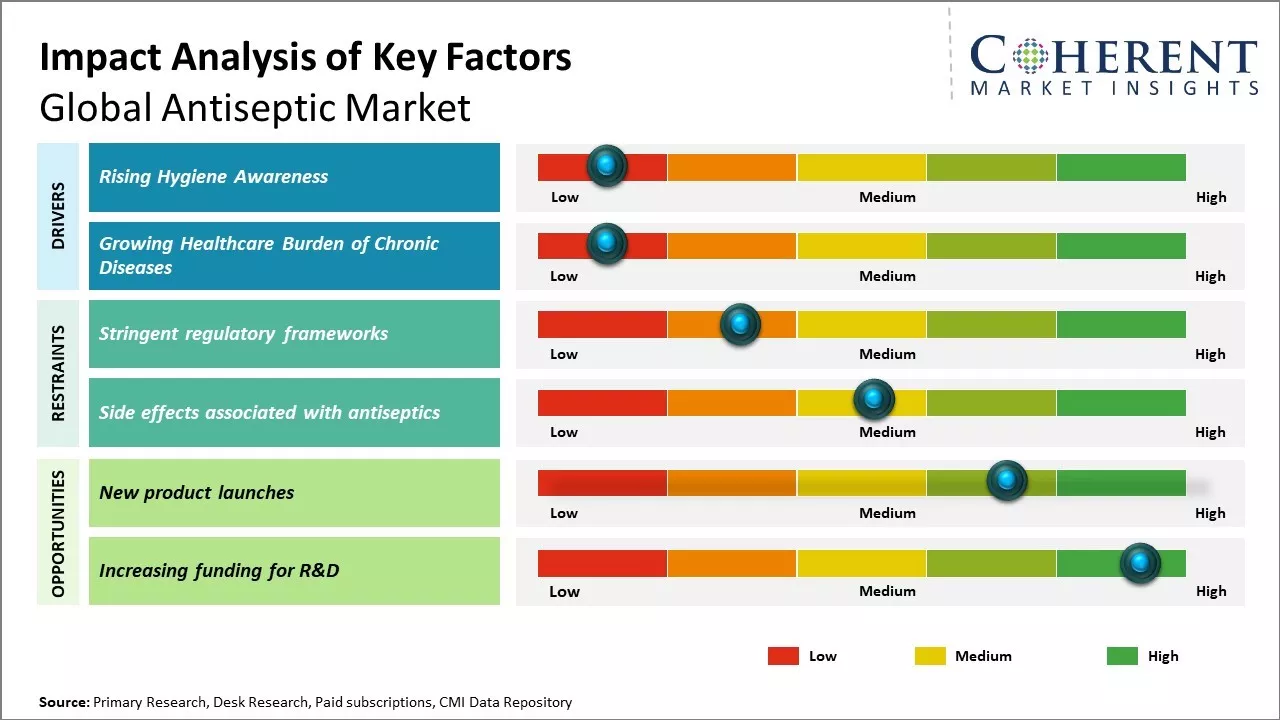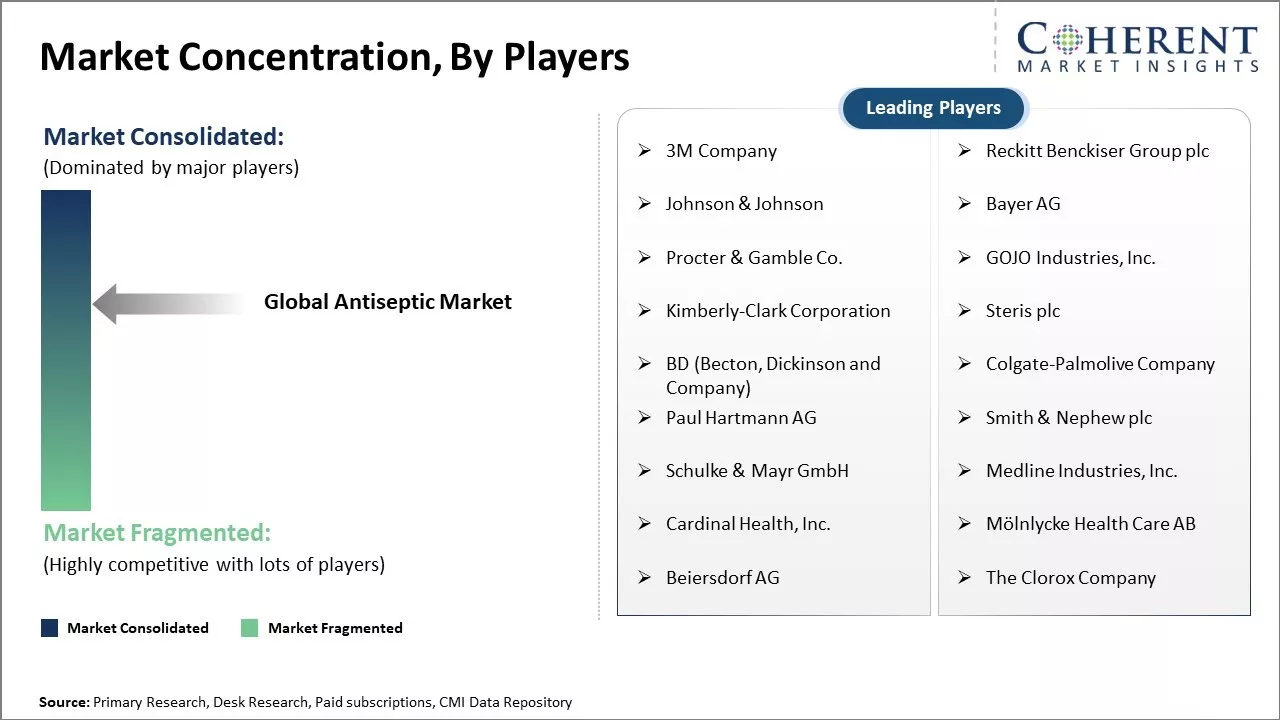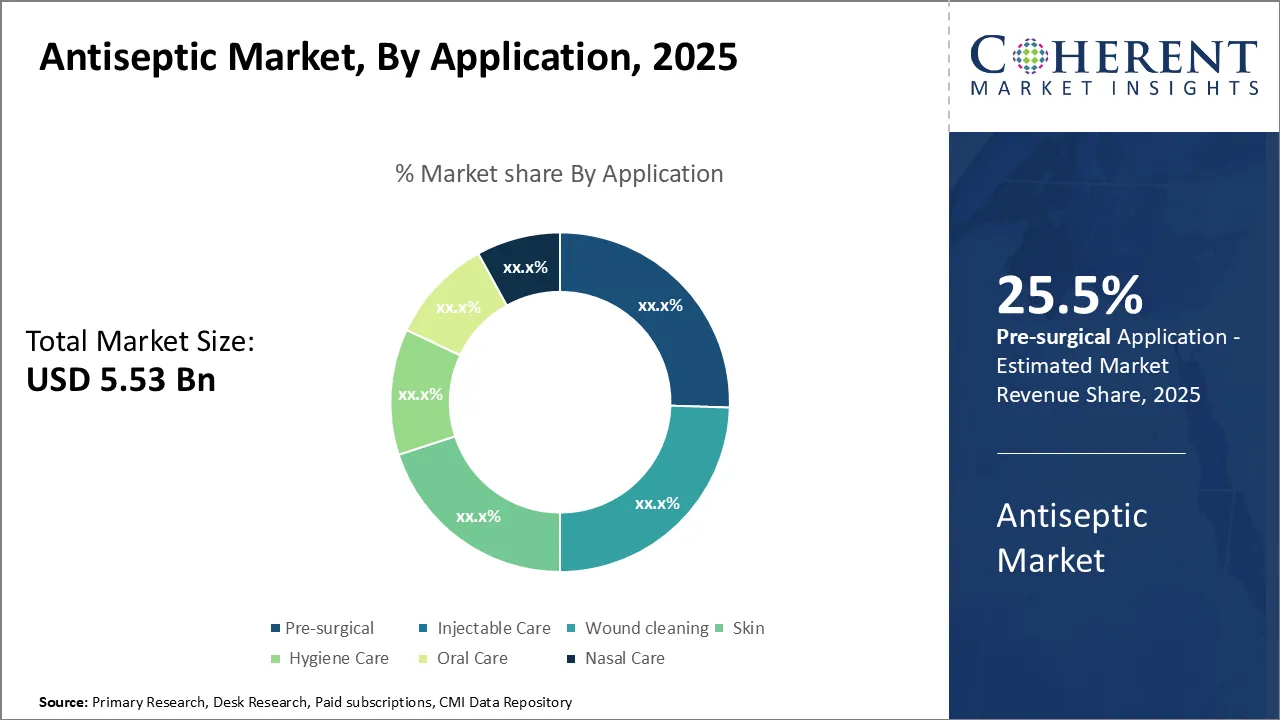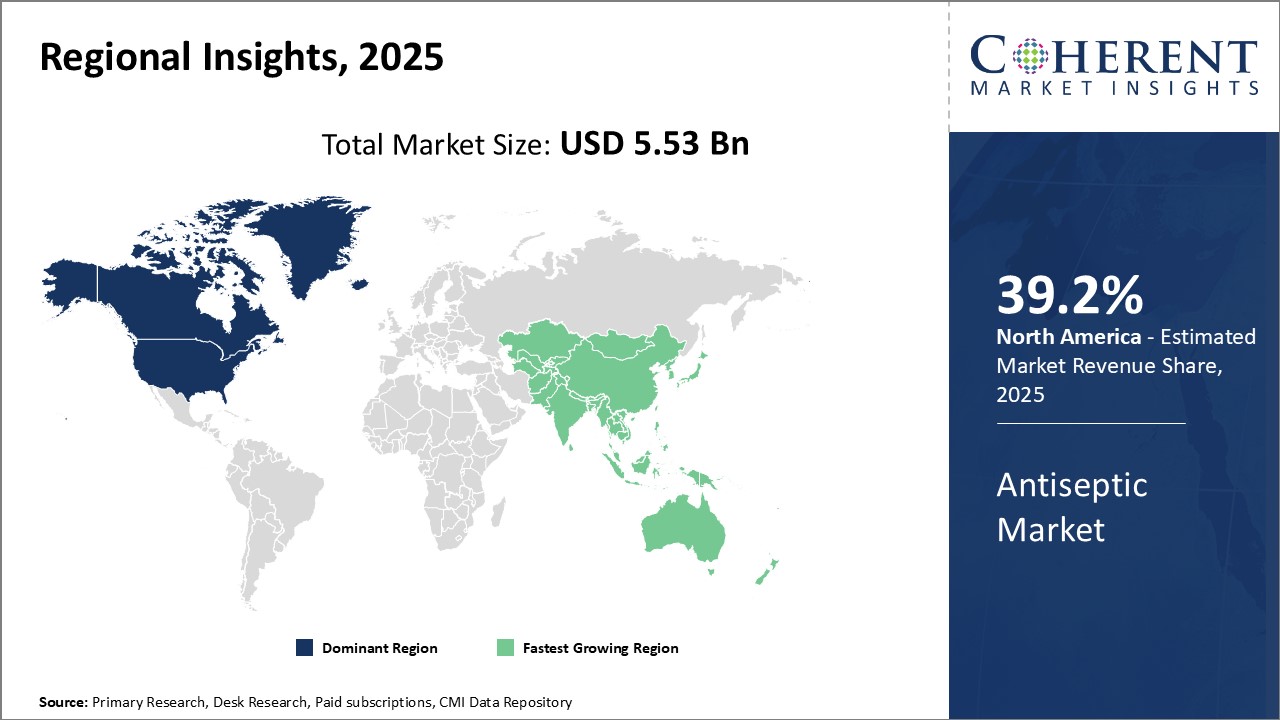The global antiseptic market is estimated to be valued at USD 5.53 Bn in 2025 and is expected to reach USD 9.68 Bn by 2032, exhibiting a compound annual growth rate (CAGR) of 8.3% from 2025 to 2032.

Discover market dynamics shaping the industry: Request sample copy
The market has been witnessing steady growth over the past few years owing to the rising awareness about healthcare associated infections and increasing prevalence of chronic diseases.
The antiseptic market is anticipated to witness considerable growth during the forecast period. This is attributed to factors such as growing demand for antiseptics from hospitals and clinics due to increasing healthcare expenditure and surgeries being performed. Furthermore, rising awareness about individual health and hygiene along with growing geriatric population prone to infections is also expected to support the antiseptic market expansion throughout the projected timeframe.
Rising Hygiene Awareness
As people have become more educated about diseases and infections, they are increasingly taking measures to prevent the spread of germs. Regular hand washing has been promoted as one of the most effective ways to avoid catching colds, flu, and other illnesses. However, merely washing hands with water is not enough, as hands can still harbor microbes even after rinsing. This is where antiseptic soaps and hand sanitizers have become invaluable. Their active ingredients like triclosan and alcohol work to eliminate 99.9% of bacteria and viruses on skin surfaces. In hospitals and other medical facilities, strict hygiene protocols now require nurses and doctors to disinfect their hands before and after contact with each patient using an antiseptic formulation. Schools have also jumped on the bandwagon, keeping bottles of sanitizers in classrooms so kids can clean their hands regularly throughout the day. Even in offices, antiseptic wipes are commonly found near photocopiers and other shared equipment which see a lot of traffic. As awareness regarding infection prevention continues to permeate all areas of public life, the global antiseptic market is set to benefit greatly from this increased emphasis on personal and community hygiene.

Get actionable strategies to beat competition: Request sample copy
Growing Healthcare Burden of Chronic Diseases
The rising worldwide prevalence of chronic health conditions like diabetes, cancer, organ failures, skin diseases, and respiratory illnesses has created sustained demand for various medical services. People with compromised immunity or ongoing medical treatments are at higher risk of contracting hospital-acquired infections. At the same time, minor cuts, wounds or skin disruptions in such patients can easily become severe without proper disinfection and dressing. This makes antiseptics an important category of drugs that supports overall healthcare delivery. In hospitals and clinics, antiseptics feature extensively in disinfecting equipment and environmental surfaces. They are also integral to effective wound management, with different formulation types available for cleaning, debriding and dressing injured areas. As life expectancy lengthens globally and non-communicable diseases place a growing burden on medical infrastructure, the antiseptic market is poised to expand significantly in lockstep with this healthcare sector growth. Continuous innovations in product deliveries like single-use applicators and spray formulations are further fueling the market’s advancement.
Key Takeaways from Analyst:
The global antiseptic market is poised to witness steady growth over the next decade driven by rising awareness about healthcare associated infections and increasing prevalence of chronic diseases. Growing geriatric population susceptible to infections is another key factor propelling the demand for antiseptics globally. However, stringent regulations pertaining to the usage of antiseptic ingredients may slow the market expansion to some extent.
North America currently dominates the antiseptic market owing to a well-established healthcare infrastructure and high healthcare spending in the region. Asia Pacific is expected to emerge as the most lucrative market attributed to the rising healthcare standards and growing medical tourism industry in countries like India and China. Large patient pool being treated makes Asia Pacific the fastest growing region.
Manufacturers have opportunities to cater to the rising demand for antiseptic products with natural and herbal formulations. Innovation and development of antiseptics that are effective against drug-resistant microbial strains while limiting toxic effects will be the next growth driver. Strong distribution networks along with increasing private label offerings by retailers provides gains. However, companies must comply with changing international quality standards and safety regulations.
Market Challenges: Stringent regulatory frameworks
Stringent regulatory frameworks across various regions are negatively impacting the growth of the global antiseptic market. Governments are focusing on enforcing strict rules and guidelines for manufacturing, testing, and marketing antiseptics to ensure product safety and efficacy. This involves lengthy registration and approval processes as well as compliance with good manufacturing practices. For instance, the U.S. FDA regulates antiseptics under the Federal Food, Drug, and Cosmetic Act. Any new antiseptic active ingredient or product is required to undergo a rigorous multi-step approval process including preliminary evaluation, non-clinical laboratory and clinical studies, and review of manufacturing methods before being marketed. Similarly, the European Medicines Agency regulates antiseptics through the Biocidal Products Regulation which mandates chemicals to go through a hazard and risk assessment before authorization. These long registration timelines increase the cost of product development and market entry for manufacturers. Furthermore, regulatory standards are constantly evolving. Changes in norms such as reclassification of products from general use to professional use only can impact sales. For example, in 2020 the USFDA reclassified several active ingredients commonly used in over-the-counter antiseptic washes from general to professional use based on a lack of substantial evidence of effectiveness. This restriction slowed sales growth in the consumer segment. Stringent advertising and labeling rules also influence marketing strategies.
Market Opportunities: New product launches
New product launches in the antiseptic space have great potential to drive significant growth in the global antiseptic market. With the COVID-19 pandemic underscoring the importance of hygiene and infection prevention, consumers are demonstrating a heightened awareness of the need for antiseptic and sanitizing products. Manufacturers who are able to develop innovative new formulations that meet this increased demand could see considerable success. In particular, multi-purpose antiseptics that can be used across settings like the home, office, school and healthcare facilities may appeal to time-pressed consumers looking for convenient, one-stop solutions. Products targeting specific concerns like surface sanitization or hand hygiene could also fill important needs highlighted by the ongoing situation. Beyond COVID-19, long-term trends point to further opportunities from new antiseptic products. As populations age in many parts of the world and healthcare costs rise, there will be increased emphasis on preventing infections and illnesses rather than just treating them. Easy-to-use antiseptic options that consumers can incorporate into their daily routines could help with this shift towards preventative health maintenance. Novel delivery forms like sprays and wipes are seeing more traction as lifestyles stay busy. Developing antiseptics in user-friendly formats like these would position companies well for future growth. Antimicrobial resistance is also a rising issue according to the World Health Organization, necessitating ongoing research and development to keep up with evolving microbes. Innovations enhancing the efficacy of antiseptics could ensure their ongoing ability to fight infection.

Discover high revenue pocket segments and roadmap to it: Request sample copy
By Application - Demand for effective pre-operative infection prevention drives the pre-surgical segment growth
In terms of application, the pre-surgical segment is expected to contribute 25.5% of the market share in 2025 owing to the need for stringent infection prevention measures prior to surgeries and invasive procedures. Pre-surgical antiseptics play a key role in disinfecting the surgical site and maintaining asepsis. Their efficacy in killing or inhibiting a wide range of microorganisms, including bacteria, fungi, and viruses, makes them irreplaceable for pre-surgical skin preparation. With rising rates of hospital-acquired infections worldwide, adherence to strict pre-operative cleaning and disinfection protocols has become a top priority for healthcare systems. This is fueling the demand for high-quality, skin-friendly pre-surgical antiseptics. Furthermore, the growing volume of surgeries performed globally each year as a result of the aging population and increasing incidence of chronic diseases strengthens the market growth. Continuous innovations to develop more effective and convenient pre-surgical antiseptic formulations will also support the leading position of this segment.
By Form - Liquid & Foam formulations facilitate efficient antiseptic application
In terms of form, the liquid & foam segment is expected to contribute 30.5% of the market share in 2025 owing to the ease of application and conformity they offer compared to other formats. Liquid and foam antiseptics can be quickly and evenly distributed over the target area through spraying or rinsing. Their fluid characteristics allow for seamless coverage of all surfaces, without retaining excess product or leaving residues. This ensures optimal microbial elimination. Liquid antiseptics are also increasingly being packaged in pre-moistened wipes or towelettes for single-use convenience, especially in ambulatory settings. Their low viscosity permits effortless penetration into skin cracks and crevices to eliminate organisms. With rising demand for user-friendly antiseptic delivery systems, liquid and foam formulations have emerged as the simplest and most effective hands-free options
By End user - Growing patient dependency on home healthcare powers homecare settings segment
In terms of end user, the homecare settings segment is expected to contribute 30.5% of the market share in 2025 due to the rising preference for medical treatment and post-discharge care at home. Propelled by factors like the rapidly aging population, increasing healthcare costs and recent advancements in home-based technologies, more patients now rely on home healthcare services for recovery, wound management and long-term care. This growing shift towards home-based care is augmenting the demand for antiseptics intended for self-application or administration by families and caregivers. These antiseptics often come pre-packaged in user-friendly formats suitable for home environments with less supervision. Their availability in adjustable formats according to needs and wound types also supports market growth. Additionally, patient education programs emphasizing hygiene maintenance through regular antiseptic use further stimulate sales within the homecare segment.

Need a Different Region or Segment? Customize now
North America currently dominates the global antiseptic market. The region is expected to account for 39.2% of the market share in 2025 owing to well-established industry presence and large healthcare expenditure in the region. The U.S. antiseptic industry is spearheaded by major players like 3M, Johnson & Johnson, and Reckitt Benckiser. These players have expanded their geographical footprint extensively in the region and invested significantly in R&D and product innovations. Furthermore, relatively higher product availability and strong brand recognition alongside stringent regulatory standards aid the regional market growth.
On the other hand, the Asia Pacific region possesses immense potential as the fastest growing market for antiseptics globally. The region is witnessing economic development along with increased healthcare investments in majority of the countries. Rapidly growing population and ensuing demand for antiseptic products boosts the regional market. Local manufacturers in countries like China and India are making efforts to capture this demand via cost-effective production offerings. Additionally, improving accessibility of healthcare services in rural areas complements regional market growth. Export opportunities for Asian antiseptic producers also appear lucrative, given the proximity to other developing regions. However, price sensitivity remains a key factor impacting sales volumes in Asia Pacific.
Antiseptic Market Report Coverage
| Report Coverage | Details | ||
|---|---|---|---|
| Base Year: | 2024 | Market Size in 2025: | USD 5.53 Bn |
| Historical Data for: | 2020 To 2024 | Forecast Period: | 2025 To 2032 |
| Forecast Period 2025 to 2032 CAGR: | 8.3% | 2032 Value Projection: | USD 9.68 Bn |
| Geographies covered: |
|
||
| Segments covered: |
|
||
| Companies covered: |
3M Company, Reckitt Benckiser Group plc, Johnson & Johnson, Bayer AG, Procter & Gamble Co., GOJO Industries, Inc., Kimberly-Clark Corporation, Steris plc, BD (Becton, Dickinson and Company), Colgate-Palmolive Company, Paul Hartmann AG, Smith & Nephew plc, Schulke & Mayr GmbH, Medline Industries, Inc., Cardinal Health, Inc., Mölnlycke Health Care AB, Beiersdorf AG, and The Clorox Company |
||
| Growth Drivers: |
|
||
| Restraints & Challenges: |
|
||
Uncover macros and micros vetted on 75+ parameters: Get instant access to report
Share
Share
About Author
Vipul Patil is a dynamic management consultant with 6 years of dedicated experience in the pharmaceutical industry. Known for his analytical acumen and strategic insight, Vipul has successfully partnered with pharmaceutical companies to enhance operational efficiency, cross broader expansion, and navigate the complexities of distribution in markets with high revenue potential.
Missing comfort of reading report in your local language? Find your preferred language :
Transform your Strategy with Exclusive Trending Reports :
Frequently Asked Questions
Joining thousands of companies around the world committed to making the Excellent Business Solutions.
View All Our Clients
US Reciprocal Tax Impact Analysis On Antiseptic Market
Stay updated on tariff changes with expert insights and timely information